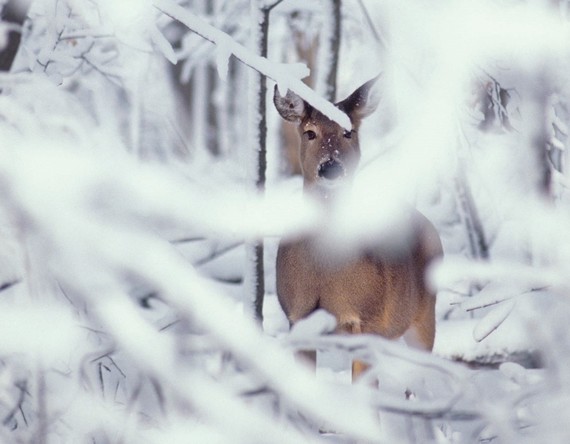
Deer season isn’t done
If you haven’t harvested a deer yet this season, don’t fret. Muzzleloader season started Dec. 4 and runs through Dec. 19. Archery and deer reduction zone seasons are still open, with archery ending Jan. 2 and deer reduction zones remaining open through Jan. 31. Although the special antlerless firearms season is closed this year (see page 27 of Indiana Hunting & Trapping Guide for details), hunters can use firearms for the deer reduction zone season, in accordance with local ordinances. Remember you’ll need permission from the landowner before hunting on properties located within deer reduction zones.
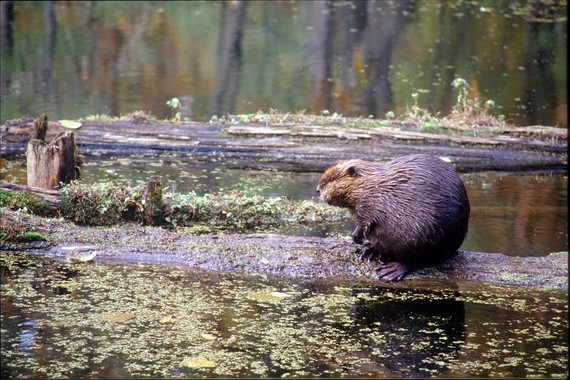
Public comments welcome on proposed changes
| The Natural Resources Commission (NRC) has given preliminary adoption to the following rule changes governing fishing tournament licenses/permits, trapping wild animals, and registering to be an organ donor through the DNR’s license system. The deadline for submitting comments is Friday, Jan. 7. For more information about the proposed changes, visit our website.
Public comments can be submitted online to the NRC. Click on “Comment on this Rule†next to the Property Rule Amendments.
Comments on the proposed changes can also be mailed to:
Natural Resources Commission
Indiana Government Center North
100 North Senate Avenue, Room N103
Indianapolis, IN 46204-2200
The virtual public hearing has been scheduled for Thursday, Jan. 6, at 5 p.m. ET.
Individuals may join the public hearing in two ways:
- To join by phone using only audio, please dial 1-415-655-0001. When prompted, enter access code 23144512102##.
- To join using video, go to this website address, enter the meeting number (2314 451 2102) and password (WriZ4ddmM82). Please note: If you have never used WebEx, we suggest that you begin the process at least 10 minutes early because you will be prompted to download WebEx before joining the meeting.
|
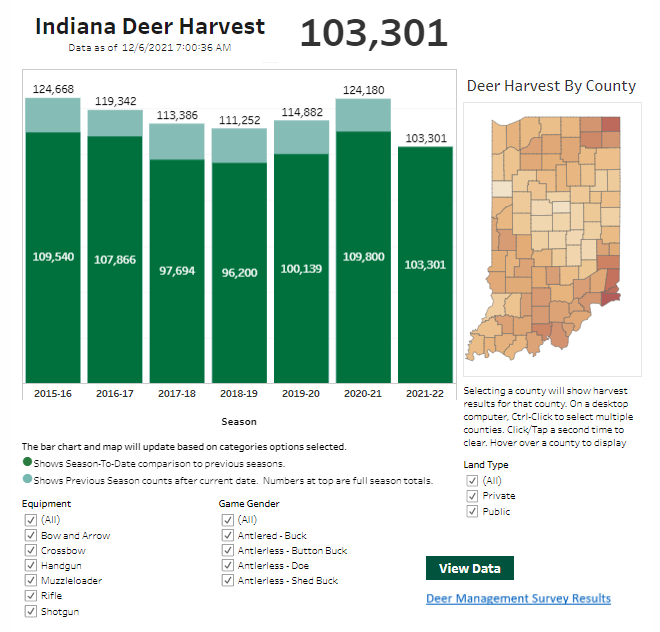
Screenshot of Indiana Deer Harvest website, taken Dec. 6, 2021.
All the deer information you need and more
Find all the information you need for a successful deer hunt on one webpage. Keep track of current harvest data and comparisons to previous seasons. This information is updated daily during deer season.
Have questions about deer seasons or regulations? Use our Deer Hotline by emailing INDeerHotline@dnr.IN.gov or calling 812-334-3795, 8:30 a.m. to 4 p.m. ET, Monday through Friday.
Check in your deer, wild turkey, or river otter
The Indiana CheckIN Game system allows hunters and trappers to check in their harvested game from any device connected to the internet. You will receive a confirmation number that must be written down on a temporary transportation tag for the harvested game species (turkey, deer). Be sure to check your information is accurate before submitting.
Find other options for checking in your harvested game online. See the results of hunting and trapping seasons so far for deer, wild turkey, and river otter.
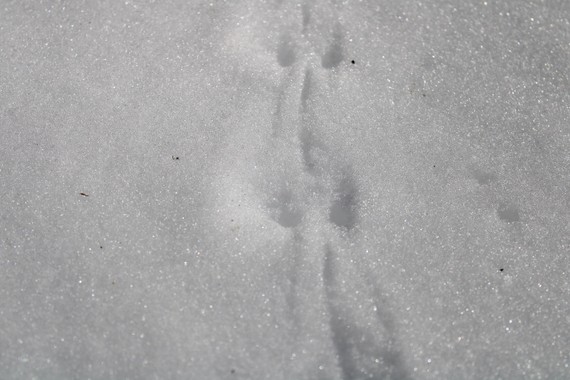
Mouse tracks in the snow.
Enjoy the fresh air and track wildlife this winter
Tracking wildlife is an amazing way to connect with nature. Reading and interpreting animal sign is a vital skill for hunters and trappers to learn, but it’s useful for anyone who wants to view wildlife. One of the best times to practice your tracking is in the winter, after the snow falls. Fresh snow is like a blank page that makes it easy to read where animals have left their mark. For hunters and trappers, this is an excellent time to take an in-depth look at how animals are moving around the landscape and make more accurate predictions about their patterns. This winter, grab your favorite animal track and sign guidebook and head out to a DNR property near you to practice! Remember: Wearing fluorescent orange (“hunter orangeâ€) is always a good practice while enjoying the outdoors during hunting seasons.
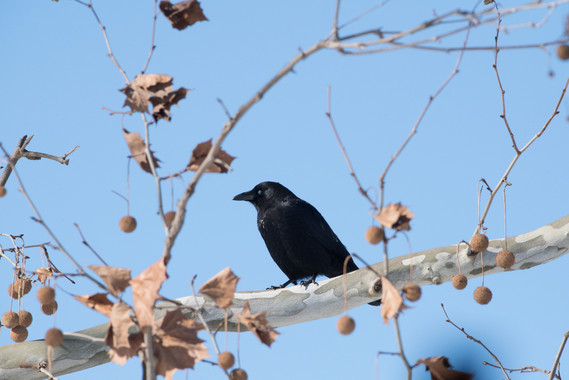
Photo courtesy of Brendan Kearns.
Hunting seasons in December
Deer Muzzleloader: Dec. 4 – 19
Wild Turkey Fall Archery: Dec. 4 – Jan. 2, 2022
Pheasant (Cock only): Closes Dec. 15
Dove: Dec. 11 – Jan. 1, 2022
Crow: Dec. 13 – March 1, 2022
Snipe: Closes Dec. 16
Quail (north of Interstate 74): Closes Dec. 15
Ducks (North Zone): Closes Dec. 12, reopens Dec. 26–Jan. 3. 2022
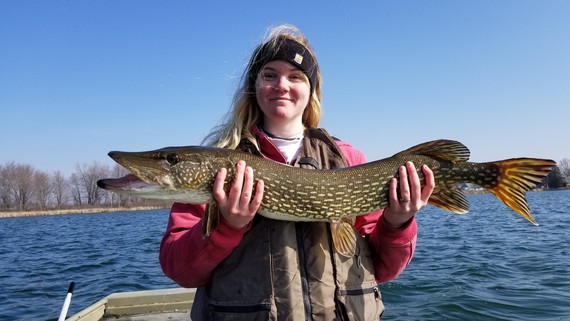
Fishing in the cold
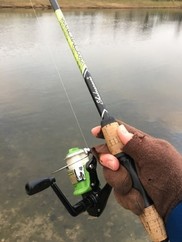 The air is cold and winter is near, but open-water fishing season isn’t quite over. Fish move slowly in cold water, but they will bite because they still need to eat. The air is cold and winter is near, but open-water fishing season isn’t quite over. Fish move slowly in cold water, but they will bite because they still need to eat.
An occasional twitch of a jerkbait or a sinking, fluttering crankbait or spoon can imitate dying baitfish and can trigger strikes. If those lures are not working, cast smaller lures with light line and reel in slowly. Try small jigs with hair, feathers, tiny spider-like legs, or a soft plastic tail. Live bait on small hooks under small bobbers can also result in success.
Mid- to late afternoon is the best time to fish in winter; stop at a city park lake for a few minutes after work or make a few casts at the neighborhood pond when you get home. Dress warmly, keep your toes and fingers dry, and be patient. Enjoy the day’s last rays of sunshine and the fresh crisp air. Getting outside is good for the body and the mind. |
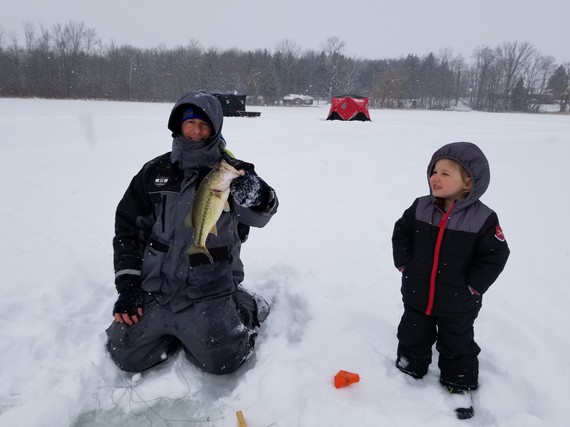
Ice fishing basics: gear up
Ever try ice fishing? While we likely won’t see ice on our waters that is safe to walk onfor weeks, this is a good time to think about the gear you’ll need to go ice fishing, especially with the holidays approaching. Here are some basic items you will need to get started:
- Rod & reel: Like open water fishing tackle, ice fishing rods and reels can range widely in price. Start with an inexpensive combo (rod and reel sold together) – you can always upgrade later. The rods are usually 2-3 feet in length and have an open-face reel with 2-pound line. If the rod doesn’t come with a strike indicator at the tip of the rod (a small device that indicates strikes on your line), purchase one separately for just a few dollars – these work better than bobbers floating in the slush of the hole.
- Lures and bait: Get an assortment of tiny jigs, hooks, and soft plastics. Store them in a small tackle box. Bee moth larvae work well too, but don’t let them freeze.
- Auger: You’ll need an auger to drill a hole through the ice. Augers are powered manually, by battery, or with gas.
- Slush scoop or deep ladle to keep the hole clear of ice and slush.
- Five-gallon bucket to keep tackle and tools contained, provide a place to sit, and to carry any harvested fish.
- Winter gear: Coveralls or snowmobile suit, layers of clothing, scarf, hat, waterproof and insulated boots, and waterproof or water-resistant gloves. Ice cleat attachments on your boots aren’t necessary but will keep you from slipping on the ice.
- Life jacket: Wearing a life jacket can provide an extra layer of warmth and could save your life if you fall though the ice.
- Ice safety picks are plastic handles with metal spikes that are connected by a cord or rope. You can wear these around your neck, and they will help you pull yourself out if you break through the ice.
- Optional: Plastic sled to pull the bucket, drinks, snacks, and other gear.
Plan to check out the January and February editions of Wild Bulletin for our upcoming articles on ice fishing safety and techniques.
How to store your fishing equipment for winter weather
If you don’t plan to fish again until spring, here are some tackle storage tips to keep your gear ready to go until next year.
- If your fishing line is in good condition, you can use it again next year. Monofilament line can be removed from the reel and wrapped up like an extension cord to keep it from coiling. Keeping it out of direct sunlight and extreme heat lengthens the line’s life. Keep other types of line right on the reel.
- If the line has rough spots or feels weak, you should replace the line now or before you use it again in the spring.
- Clean the reel inside and out with mild soapy water and an old, clean toothbrush. Make sure to dry the reel completely. Lubricate parts with fishing reel oil and grease. Loosen the drag to ease the pressure of the gears inside.
- Check the rod’s line guides for rough spots. Replace damaged guides yourself or bring the rod to a local fishing retailer.
- Wipe down all parts of the rod and store it away from critters that might chew on soft parts. Store vertically or horizontally using a rod rack to keep it straight.
- Remove and inventory everything from the tackle box and clean it out. Clean and lubricate the pliers. All metal parts should be stored dry and kept dry. Try organizing the tackle box in different ways.
If you have multiple fishing rods, leave one out just in case. If our lakes and ponds get enough ice this winter, ice fishing is a fun option!
Fishing-themed gift ideas for friends and family
Do you hope to get the special angler in your life something for the holidays? Here are some gift ideas, from stocking stuffers to memorable experiences for those who like to spend time at, in, or on the water:
- $0-5: lip balm (with SPF), package of hooks (size 8 or 3/0), lures like 1/8 oz. inline spinner, 3/8 oz. spinner bait, package of 1/15 oz. mushroom style jig heads, or a package of 3†black plastic stick baits
- $5-10: sunscreen, spool of 6 lb. monofilament line, package of 6-8†black plastic worms, ice fishing ice scoop, fishing reel oil and grease combo pack
- $10-20: fishing pliers, package of assorted ice fishing jigs, ice fishing gloves
- $20-50: polarized sunglasses, fishing rod holder, ice fishing spinning combo
- $50-100: ice fishing auger, fishing life jacket, waders with boots
- $100-150: inflatable life jacket, fly fishing lessons
- $150-400: kayak, fish finder, trolling motor, guided creek, river, lake, or muskie fishing trip (half or full day trip)
- $400-1,000: Lake Michigan charter fishing trip, fishing kayak

Sauger fishing on the Ohio River
A reliable winter fish, sauger readily bite in water temperatures below 40 degrees. As water temperatures fall, sauger congregate where streams meet and move to the tailwaters below dams for the winter. On the Ohio River, good sauger fishing starts in December and lasts through the spawn in late March.
From a boat, fish vertically with ¼- to ¾-ounce jigs tipped with curly tail grubs. Bring a variety of colors to see what gets bites. Sauger like to hug the bottom, so use the lightest jig that’s heavy enough to reach the bottom in the current. From shore, fish using a similar setup while casting over seams in the current and water breaks. If fishing is slow, adding a live minnow might get the bite going.
When fishing in tailwaters, remain alert of changing river conditions. Avoid restricted zones near the dam and beware of traffic near the lock chambers. Find public access sites on Ohio River using our Where to Fish interactive map.
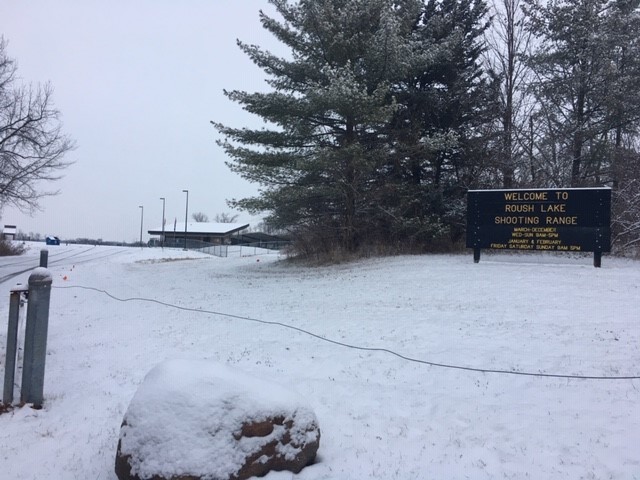
Shooting range hours adjust soon
Planning to visit a DNR shooting range soon? Remember our normal range hours adjust during winter. Most Fish & Wildlife area shooting ranges are only open Friday, Saturday, and Sunday during January and February. You can find the most up-to-date hours on our website.
Winter is a great time to prep and plan wildlife habitat
Landowners interested in developing wildlife habitat can take advantage of winter conditions to improve their property’s resources. For those who started preparing sites for seed-to-soil contact in fall, our biologists recommend waiting until a thin layer of snow is on the ground before starting winter seeding. The snow will make it easy to see where seeds have already been spread, reducing waste. Now is also a great time to gather limbs and other downed material to create brush piles, which make great shelters for different wildlife species, including rabbits.
If you want to create or improve habitat on your property next year, get in contact with your district wildlife biologist with your goals and ideas to start planning. Learn about our wildlife habitat landowner assistance programs online.

Peregrine falcon chick receiving a leg band before being placed back in its nest box.
Purchase a present for Indiana’s wildlife
The Indiana Nongame Wildlife Fund supports habitat management and conservation efforts for more than 160 species of greatest conservation need. Donations have helped in the recovery of the bald eagle and river otters, and increased the numbers of osprey, barn owls, and Eastern hellbenders. Depending on the amount, your donation could be equivalent to:
- $10 – buys a band for a peregrine falcon so we can learn where they live and how long they survive
- $50 – buys a handcrafted least tern decoy to use to attract these rare birds to safe nesting islands
- $100 – buys a radio collar used to follow the success of a released Allegheny woodrat
- $150 – buys a barn owl nest box to replace lost nesting habitat
- $200 – buys a lake sturgeon transmitter used to find and protect their spawning habitat
These wildlife species and their habitats are essential to our quality of life, from improving environmental health to providing opportunities to see beautiful and unique animals across Indiana. Consider donating today!
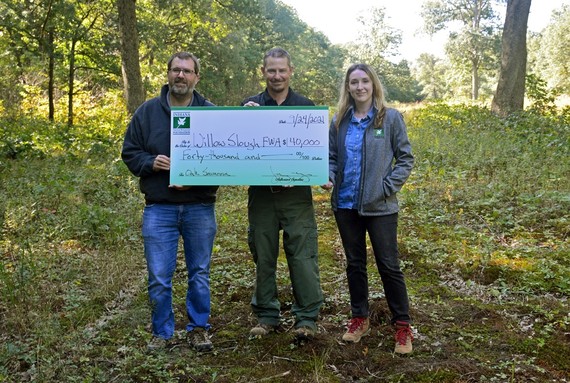
Willow Slough FWA receives donation to restore habitat
Thanks to a generous donation of $40,000 from the Indiana Natural Resources Foundation, Willow Slough Fish & Wildlife Area (FWA) will restore more than 100 acres of savanna, which is a type of grassland habitat. Grasslands are one of the most threatened habitat types in Indiana. These unique areas provide a home to dozens of grassland-specialized species, including badgers and ornate box turtles. Savannas also benefit species like wild turkey, deer, Northern bobwhite, and rabbit.
Recent news releases
Deer Creek FWA shooting range seeks concessionaire
Public hearing set for proposed wildlife rule changes
2022 LARE application deadline is Jan. 15
Walleye stocked in northern Indiana
DNR stocked 5,228 trout this fall
Goose Pond FWA adds displays to Visitor Center
DNR stocks over 80,000 Coho salmon in northwest Indiana tributaries |
|
More
 |
|
The Indiana Natural Resources Foundation celebrates and preserves Indiana’s natural legacy by raising funds to support the Indiana Department of Natural Resources (DNR) and its programs. Together, we have helped expand public lands, restore wildlife habitat, and create outdoor educational and recreational opportunities for Hoosiers. |
About Fish and Wildlife Management in IndianaÂ
Fish and wildlife management and public access are funded by fishing and hunting license revenue and also through the Wildlife and Sport Fish Restoration Programs administered by the U.S. Fish & Wildlife Service. These programs collect excise taxes on sporting arms and ammunition, archery equipment, fishing equipment, and motor boat fuels. The money is distributed among state fish and wildlife agencies based on land size and the number of licensed anglers and hunters in each state. Find out more information about fish and wildlife management in Indiana at Wildlife.IN.gov.
|
|
|
|
|
|

Deer season isn’t done
If you haven’t harvested a deer yet this season, don’t fret. Muzzleloader season started Dec. 4 and runs through Dec. 19. Archery and deer reduction zone seasons are still open, with archery ending Jan. 2 and deer reduction zones remaining open through Jan. 31. Although the special antlerless firearms season is closed this year (see page 27 of Indiana Hunting & Trapping Guide for details), hunters can use firearms for the deer reduction zone season, in accordance with local ordinances. Remember you’ll need permission from the landowner before hunting on properties located within deer reduction zones.

Public comments welcome on proposed changes
| The Natural Resources Commission (NRC) has given preliminary adoption to the following rule changes governing fishing tournament licenses/permits, trapping wild animals, and registering to be an organ donor through the DNR’s license system. The deadline for submitting comments is Friday, Jan. 7. For more information about the proposed changes, visit our website.
Public comments can be submitted online to the NRC. Click on “Comment on this Rule†next to the Property Rule Amendments.
Comments on the proposed changes can also be mailed to:
Natural Resources Commission
Indiana Government Center North
100 North Senate Avenue, Room N103
Indianapolis, IN 46204-2200
The virtual public hearing has been scheduled for Thursday, Jan. 6, at 5 p.m. ET.
Individuals may join the public hearing in two ways:
- To join by phone using only audio, please dial 1-415-655-0001. When prompted, enter access code 23144512102##.
- To join using video, go to this website address, enter the meeting number (2314 451 2102) and password (WriZ4ddmM82). Please note: If you have never used WebEx, we suggest that you begin the process at least 10 minutes early because you will be prompted to download WebEx before joining the meeting.
|

Screenshot of Indiana Deer Harvest website, taken Dec. 6, 2021.
All the deer information you need and more
Find all the information you need for a successful deer hunt on one webpage. Keep track of current harvest data and comparisons to previous seasons. This information is updated daily during deer season.
Have questions about deer seasons or regulations? Use our Deer Hotline by emailing INDeerHotline@dnr.IN.gov or calling 812-334-3795, 8:30 a.m. to 4 p.m. ET, Monday through Friday.
Check in your deer, wild turkey, or river otter
The Indiana CheckIN Game system allows hunters and trappers to check in their harvested game from any device connected to the internet. You will receive a confirmation number that must be written down on a temporary transportation tag for the harvested game species (turkey, deer). Be sure to check your information is accurate before submitting.
Find other options for checking in your harvested game online. See the results of hunting and trapping seasons so far for deer, wild turkey, and river otter.

Mouse tracks in the snow.
Enjoy the fresh air and track wildlife this winter
Tracking wildlife is an amazing way to connect with nature. Reading and interpreting animal sign is a vital skill for hunters and trappers to learn, but it’s useful for anyone who wants to view wildlife. One of the best times to practice your tracking is in the winter, after the snow falls. Fresh snow is like a blank page that makes it easy to read where animals have left their mark. For hunters and trappers, this is an excellent time to take an in-depth look at how animals are moving around the landscape and make more accurate predictions about their patterns. This winter, grab your favorite animal track and sign guidebook and head out to a DNR property near you to practice! Remember: Wearing fluorescent orange (“hunter orangeâ€) is always a good practice while enjoying the outdoors during hunting seasons.

Photo courtesy of Brendan Kearns.
Hunting seasons in December
Deer Muzzleloader: Dec. 4 – 19
Wild Turkey Fall Archery: Dec. 4 – Jan. 2, 2022
Pheasant (Cock only): Closes Dec. 15
Dove: Dec. 11 – Jan. 1, 2022
Crow: Dec. 13 – March 1, 2022
Snipe: Closes Dec. 16
Quail (north of Interstate 74): Closes Dec. 15
Ducks (North Zone): Closes Dec. 12, reopens Dec. 26–Jan. 3. 2022

Fishing in the cold
 The air is cold and winter is near, but open-water fishing season isn’t quite over. Fish move slowly in cold water, but they will bite because they still need to eat. The air is cold and winter is near, but open-water fishing season isn’t quite over. Fish move slowly in cold water, but they will bite because they still need to eat.
An occasional twitch of a jerkbait or a sinking, fluttering crankbait or spoon can imitate dying baitfish and can trigger strikes. If those lures are not working, cast smaller lures with light line and reel in slowly. Try small jigs with hair, feathers, tiny spider-like legs, or a soft plastic tail. Live bait on small hooks under small bobbers can also result in success.
Mid- to late afternoon is the best time to fish in winter; stop at a city park lake for a few minutes after work or make a few casts at the neighborhood pond when you get home. Dress warmly, keep your toes and fingers dry, and be patient. Enjoy the day’s last rays of sunshine and the fresh crisp air. Getting outside is good for the body and the mind. |

Ice fishing basics: gear up
Ever try ice fishing? While we likely won’t see ice on our waters that is safe to walk onfor weeks, this is a good time to think about the gear you’ll need to go ice fishing, especially with the holidays approaching. Here are some basic items you will need to get started:
- Rod & reel: Like open water fishing tackle, ice fishing rods and reels can range widely in price. Start with an inexpensive combo (rod and reel sold together) – you can always upgrade later. The rods are usually 2-3 feet in length and have an open-face reel with 2-pound line. If the rod doesn’t come with a strike indicator at the tip of the rod (a small device that indicates strikes on your line), purchase one separately for just a few dollars – these work better than bobbers floating in the slush of the hole.
- Lures and bait: Get an assortment of tiny jigs, hooks, and soft plastics. Store them in a small tackle box. Bee moth larvae work well too, but don’t let them freeze.
- Auger: You’ll need an auger to drill a hole through the ice. Augers are powered manually, by battery, or with gas.
- Slush scoop or deep ladle to keep the hole clear of ice and slush.
- Five-gallon bucket to keep tackle and tools contained, provide a place to sit, and to carry any harvested fish.
- Winter gear: Coveralls or snowmobile suit, layers of clothing, scarf, hat, waterproof and insulated boots, and waterproof or water-resistant gloves. Ice cleat attachments on your boots aren’t necessary but will keep you from slipping on the ice.
- Life jacket: Wearing a life jacket can provide an extra layer of warmth and could save your life if you fall though the ice.
- Ice safety picks are plastic handles with metal spikes that are connected by a cord or rope. You can wear these around your neck, and they will help you pull yourself out if you break through the ice.
- Optional: Plastic sled to pull the bucket, drinks, snacks, and other gear.
Plan to check out the January and February editions of Wild Bulletin for our upcoming articles on ice fishing safety and techniques.
How to store your fishing equipment for winter weather
If you don’t plan to fish again until spring, here are some tackle storage tips to keep your gear ready to go until next year.
- If your fishing line is in good condition, you can use it again next year. Monofilament line can be removed from the reel and wrapped up like an extension cord to keep it from coiling. Keeping it out of direct sunlight and extreme heat lengthens the line’s life. Keep other types of line right on the reel.
- If the line has rough spots or feels weak, you should replace the line now or before you use it again in the spring.
- Clean the reel inside and out with mild soapy water and an old, clean toothbrush. Make sure to dry the reel completely. Lubricate parts with fishing reel oil and grease. Loosen the drag to ease the pressure of the gears inside.
- Check the rod’s line guides for rough spots. Replace damaged guides yourself or bring the rod to a local fishing retailer.
- Wipe down all parts of the rod and store it away from critters that might chew on soft parts. Store vertically or horizontally using a rod rack to keep it straight.
- Remove and inventory everything from the tackle box and clean it out. Clean and lubricate the pliers. All metal parts should be stored dry and kept dry. Try organizing the tackle box in different ways.
If you have multiple fishing rods, leave one out just in case. If our lakes and ponds get enough ice this winter, ice fishing is a fun option!
Fishing-themed gift ideas for friends and family
Do you hope to get the special angler in your life something for the holidays? Here are some gift ideas, from stocking stuffers to memorable experiences for those who like to spend time at, in, or on the water:
- $0-5: lip balm (with SPF), package of hooks (size 8 or 3/0), lures like 1/8 oz. inline spinner, 3/8 oz. spinner bait, package of 1/15 oz. mushroom style jig heads, or a package of 3†black plastic stick baits
- $5-10: sunscreen, spool of 6 lb. monofilament line, package of 6-8†black plastic worms, ice fishing ice scoop, fishing reel oil and grease combo pack
- $10-20: fishing pliers, package of assorted ice fishing jigs, ice fishing gloves
- $20-50: polarized sunglasses, fishing rod holder, ice fishing spinning combo
- $50-100: ice fishing auger, fishing life jacket, waders with boots
- $100-150: inflatable life jacket, fly fishing lessons
- $150-400: kayak, fish finder, trolling motor, guided creek, river, lake, or muskie fishing trip (half or full day trip)
- $400-1,000: Lake Michigan charter fishing trip, fishing kayak

Sauger fishing on the Ohio River
A reliable winter fish, sauger readily bite in water temperatures below 40 degrees. As water temperatures fall, sauger congregate where streams meet and move to the tailwaters below dams for the winter. On the Ohio River, good sauger fishing starts in December and lasts through the spawn in late March.
From a boat, fish vertically with ¼- to ¾-ounce jigs tipped with curly tail grubs. Bring a variety of colors to see what gets bites. Sauger like to hug the bottom, so use the lightest jig that’s heavy enough to reach the bottom in the current. From shore, fish using a similar setup while casting over seams in the current and water breaks. If fishing is slow, adding a live minnow might get the bite going.
When fishing in tailwaters, remain alert of changing river conditions. Avoid restricted zones near the dam and beware of traffic near the lock chambers. Find public access sites on Ohio River using our Where to Fish interactive map.

Shooting range hours adjust soon
Planning to visit a DNR shooting range soon? Remember our normal range hours adjust during winter. Most Fish & Wildlife area shooting ranges are only open Friday, Saturday, and Sunday during January and February. You can find the most up-to-date hours on our website.
Winter is a great time to prep and plan wildlife habitat
Landowners interested in developing wildlife habitat can take advantage of winter conditions to improve their property’s resources. For those who started preparing sites for seed-to-soil contact in fall, our biologists recommend waiting until a thin layer of snow is on the ground before starting winter seeding. The snow will make it easy to see where seeds have already been spread, reducing waste. Now is also a great time to gather limbs and other downed material to create brush piles, which make great shelters for different wildlife species, including rabbits.
If you want to create or improve habitat on your property next year, get in contact with your district wildlife biologist with your goals and ideas to start planning. Learn about our wildlife habitat landowner assistance programs online.

Peregrine falcon chick receiving a leg band before being placed back in its nest box.
Purchase a present for Indiana’s wildlife
The Indiana Nongame Wildlife Fund supports habitat management and conservation efforts for more than 160 species of greatest conservation need. Donations have helped in the recovery of the bald eagle and river otters, and increased the numbers of osprey, barn owls, and Eastern hellbenders. Depending on the amount, your donation could be equivalent to:
- $10 – buys a band for a peregrine falcon so we can learn where they live and how long they survive
- $50 – buys a handcrafted least tern decoy to use to attract these rare birds to safe nesting islands
- $100 – buys a radio collar used to follow the success of a released Allegheny woodrat
- $150 – buys a barn owl nest box to replace lost nesting habitat
- $200 – buys a lake sturgeon transmitter used to find and protect their spawning habitat
These wildlife species and their habitats are essential to our quality of life, from improving environmental health to providing opportunities to see beautiful and unique animals across Indiana. Consider donating today!

Willow Slough FWA receives donation to restore habitat
Thanks to a generous donation of $40,000 from the Indiana Natural Resources Foundation, Willow Slough Fish & Wildlife Area (FWA) will restore more than 100 acres of savanna, which is a type of grassland habitat. Grasslands are one of the most threatened habitat types in Indiana. These unique areas provide a home to dozens of grassland-specialized species, including badgers and ornate box turtles. Savannas also benefit species like wild turkey, deer, Northern bobwhite, and rabbit.
Recent news releases
Deer Creek FWA shooting range seeks concessionaire
Public hearing set for proposed wildlife rule changes
2022 LARE application deadline is Jan. 15
Walleye stocked in northern Indiana
DNR stocked 5,228 trout this fall
Goose Pond FWA adds displays to Visitor Center
DNR stocks over 80,000 Coho salmon in northwest Indiana tributaries |
|
More
 |
|
The Indiana Natural Resources Foundation celebrates and preserves Indiana’s natural legacy by raising funds to support the Indiana Department of Natural Resources (DNR) and its programs. Together, we have helped expand public lands, restore wildlife habitat, and create outdoor educational and recreational opportunities for Hoosiers. |
About Fish and Wildlife Management in IndianaÂ
Fish and wildlife management and public access are funded by fishing and hunting license revenue and also through the Wildlife and Sport Fish Restoration Programs administered by the U.S. Fish & Wildlife Service. These programs collect excise taxes on sporting arms and ammunition, archery equipment, fishing equipment, and motor boat fuels. The money is distributed among state fish and wildlife agencies based on land size and the number of licensed anglers and hunters in each state. Find out more information about fish and wildlife management in Indiana at Wildlife.IN.gov.
|
|
|
|
|